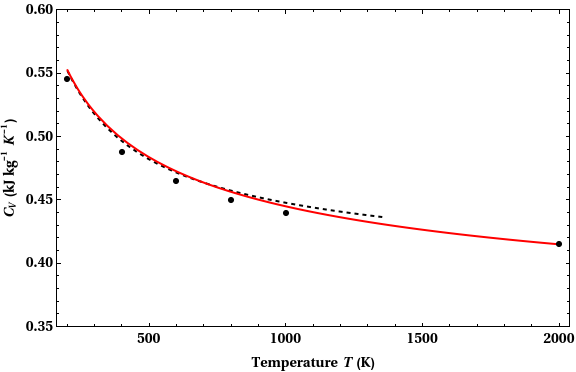NewEoSArgon
Author
Frederic Aitken, Ferdinand Volino
Title
NewEoSArgon
Description
A new non-extensive equation of state for the fluid phases of argon for temperatures from the melting line to 2300 K and pressures up to 50 GPa, based on an original approach including the metastable states
Category
Academic Articles & Supplements
Keywords
argon, equation of state, thermal and caloric properties, vapor–liquid coexistence curve, spinodal, metastable state
URL
http://www.notebookarchive.org/2024-01-8ag2wbe/
DOI
https://notebookarchive.org/2024-01-8ag2wbe
Date Added
2024-01-18
Date Last Modified
2024-01-18
File Size
55.66 kilobytes
Supplements
Rights
CC BY 4.0

NewEoSArgon
NewEoSArgon
Authors : F . Aitken and F . Volino
Description
NewEoSArgon is a Mathematica package which allows to calculate the thermodynamic equations of state of fluid ARGON from the melting line to 2300 K and for pressures up to 50 GPa. In this way, the application range of the same functions in the ThermodynamicData package for single-phase fluids can be greatly extended. However, it is a different model from the one programmed in the ThermodynamicData package, which enables, for example, metastable states to be calculated in a physically realistic way as the biphase is crossed. The first examples below demonstrate these different aspects. More extensive examples can be found in the documentation accompanying the NewEoSArgon package.
The equations of state have been published in the following reference:
“A New Non-Extensive Equation of State for the Fluid Phases of Argon, Including the Metastable States, from the Melting Line to 2300 K and 50 GPa”, Fluids 9(5), 102 (2024); https://doi.org/10.3390/fluids9050102
“A New Non-Extensive Equation of State for the Fluid Phases of Argon, Including the Metastable States, from the Melting Line to 2300 K and 50 GPa”, Fluids 9(5), 102 (2024); https://doi.org/10.3390/fluids9050102
A preprint version of the published paper can also be accessed from the arXiv open-source archive at: https://arxiv.org/abs/1504.00633
Installation
The NewEoSArgon. zip file in the “Supporting files” tab must be first downloaded. Then, the installation of the package in Mathematica is described in the ReadMe.txt file included in the zip file.
If the installation was successful then you should see a new palette in the “Palettes” menu called “NewEoSArgon”. This palette allows you to access some equations more quickly.
If the installation was successful then you should see a new palette in the “Palettes” menu called “NewEoSArgon”. This palette allows you to access some equations more quickly.
Documentation
IIf the installation was successful, you can then access the documentation through the “Help” menu in a Mathematica Notebook: click on “Wolfram Documentation” and then at the bottom of the documentation page click on “Add-ons and Packages”; in the list of “Installed Add-Ons” you should see a cell labeled “NewEoSArgon”; click on this cell to have access to the documentation of the program with many examples.
The online documentation is also available at the following address :
http://mathematica.g2elab.grenoble-inp.fr/neweosargon.html
http://mathematica.g2elab.grenoble-inp.fr/neweosargon.html
How to use the package
To be able to use the functions of the package, it is necessary to load it before any new use in a Notebook. To do this, you must write the following command and validate it:
Needs["NewEoSArgon`"]Off[General::munfl]
You can then calculate any function of the package. For example, the isochoric heat capacity of liquid argon along a high density isochor. The example below shows a comparison between data and the calculated with the NewEoSArgon package and the ThermodynamicData package. It is clear from this example that the function defined using the ThermodynamicData package is temperature-limited (i.e. around 1300 K) and deviates more and more from the data as the temperature increases.
C
V
C
V
In[]:=
(*TheisochoricheatcapacityfunctionfromtheThermodynamicDatapackage(i.e.usingREFPROPfromNIST)*)CVNIST[T_,ρ_]:=QuantityMagnitude@UnitConvertThermodynamicData"Argon","MolarIsochoricHeatCapacity","Density"Quantityρ,"Grams","Temperature"Quantity[T,"Kelvins"],"Joules/Kelvins/Moles"
3
"Centimeters"
(*ThedataoffromVrabec&Fischer(1996)*)DataVrabec={{200,0.545},{400,0.488},{600,0.465},{800,0.45},{1000,0.440},{2000,0.415}};
C
V
In[]:=
ρ=1.6;(*densitying*)LegendedPlot*CVNIST[y,ρ],*CVAdimNv[y,ρ],{y,200,2000},PlotRange{All,{0.35,0.6}},FrameTrue,FrameLabel{"Temperature T (K)"," (kJ )"},FrameStyleBlack,LabelStyleDirective[Black,Bold,14,FontFamily"Times New Roman"],PlotStyle{{Dashed,Black},Red},AxesOrigin{200,0.35},ImageSize->Large,Epilog{PointSize[0.012],Point[DataVrabec]},{Placed[PointLegend[{Directive[Black,AbsolutePointSize[6]]},{"Data from Vrabec & Fischer (1996)"}],Below],Placed[LineLegend[{Directive[Dashed,Black],Red},{"ThermodynamicData package","The NewEoSArgon package"}],Below]}
3
cm
1
M
RR
M
C
V
-1
kg
-1
K
Out[]=
 | ||||||||
|
The functions in the NewEoSArgon package have imposed units, unlike the functions in the ThermodynamicData package, which are more flexible in this respect. However, the example below shows that it is possible to use units other than those imposed, thanks to the conversion functions in the Units package.
(*DensityequationofstateofargonatatmosphericpressurefromtheThermodynamicDatapackage*)ρArNIST[T_,unitDensity_]:=UnitConvert[ThermodynamicData["Argon","Density",{"Pressure"Quantity[1,"Atmospheres"],"Temperature"Quantity[T,"Kelvins"]}],unitDensity];
In[]:=
(*Thecalculateddensitiesforatemperatureof298.15Kwithdifferentunits*)T=298.15;(*Kelvin*)ρArNIST[T,"Grams"]ρArNISTT,"Kilograms"RhoArgonNv[T,1.01325]Quantity[RhoArgonNv[T,QuantityMagnitude@Quantity[1.01325,"Bars"]],"Grams"]Quantity[RhoArgonNv[T,QuantityMagnitude@UnitConvert[Quantity[1,"Atmospheres"],"Bars"]],"Grams"]UnitConvertQuantityRhoArgonNv[T,QuantityMagnitude@UnitConvert[Quantity[1,"Atmospheres"],"Bars"]],"Grams","Kilograms"
3
"Centimeters"
3
"Meters"
3
"Centimeters"
3
"Centimeters"
3
"Centimeters"
3
"Meters"
Out[]=
0.00163386
g/
3
cm
Out[]=
1.63386
kg/
3
m
Out[]=
0.00163371
Out[]=
0.00163371
g/
3
cm
Out[]=
0.00163371
g/
3
cm
Out[]=
1.63371
kg/
3
m
Before using any of the functions, it is strongly recommended to study the corresponding documentation . The documentation can be accessed more quickly by going to the package' s corresponding palette .
Cite this as: Frederic Aitken, Ferdinand Volino, "NewEoSArgon" from the Notebook Archive (2024), https://notebookarchive.org/2024-01-8ag2wbe
Download
